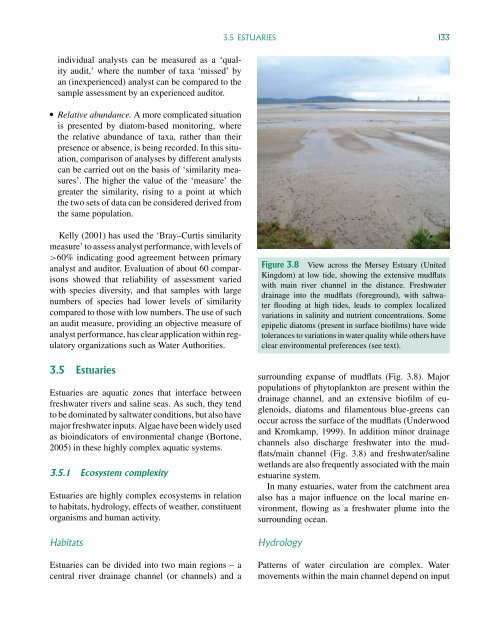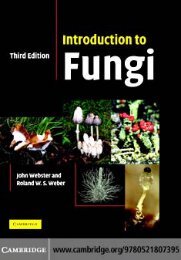132 3 ALGAE AS BIOINDICATORSBiofilm studies by Rimet et al. (2005), showed thatsome indices (e.g. CEE, TDI – high sensitivity) respondedmore rapidly than others (GDI, ILM, SLA –intermediate sensitivity) to environmental change.All indices showed significant change (integrationinterval) within 40–60 days of biofilm transfer.St<strong>and</strong>ardization of approachThe above studies indicate that benthic diatoms providethe b<strong>as</strong>is for a st<strong>and</strong>ard approach to river monitoring,able to be used <strong>as</strong> an alternative (or addition) tomacroinvertebrate sampling. Individual commonlyuseddiatom indices appear to correlate significantlywith macroinvertebrate data, <strong>and</strong> also with each other(see above). Studies by Kelly et al.(1995) have alsoshown that benthic diatom indices do not changesignificantly either with se<strong>as</strong>on or with major flowevents (both of which can influence invertebrate populations)– suggesting that diatom indices are robust<strong>and</strong> that consistent results can be obtained throughoutthe year.St<strong>and</strong>ard procedures are important in ensuringcomparability of results. These include st<strong>and</strong>ardizationof sampling procedures (Kelly et al., 1998),adoption of analyst quality controls (see below), accessto common data b<strong>as</strong>es <strong>and</strong> use of comparablediatom indices.Access to common datab<strong>as</strong>es Access to webb<strong>as</strong>eddata sites such <strong>as</strong> the European DiatomDatab<strong>as</strong>e Initiative (EDDI) promotes a st<strong>and</strong>ard approachto identification, data acquisition <strong>and</strong> manipulation.Although this site h<strong>as</strong> particularly applicationfor palaeolimnology (Section 3.2.2), other datab<strong>as</strong>esspecifically on benthic diatoms (Gosselain et al.,2005) may be more applicable to river studies.Comparable diatom indices Although a singlediatom index (coupled with the identification of keydiatom indicator taxa) would be adequate for environmentalmonitoring, the trend is for diatom countsto be fed into a datab<strong>as</strong>e for determination of multipleindices. The general availability of the OMNIDIAdatab<strong>as</strong>e software (Lecointe et al., 1993), incorporatingindices summarized in Table 3.14, is particularlyuseful in this respect.The indices contained in the OMNIDIA softwareare b<strong>as</strong>ed on European diatom communities <strong>and</strong>clearly apply most directly to European rivers. Applicationof this software in other parts of the world requiresthe incorporation of local (endemic) species, <strong>as</strong>emph<strong>as</strong>ized by Taylor et al. (2007) in their studies onSouth African rivers. It is also important to check thatcosmopolitan species have similar ecological preferencesin different parts of the world. Dela-Cruz et al.(2006), for example, <strong>as</strong>sessed the suitability of ‘northernhemisphere’ ecological tolerance/preference datafor periphytic diatoms in south-e<strong>as</strong>tern Australianrivers before using bioindicator indices.Quality <strong>as</strong>suranceAlthough techniques for st<strong>and</strong>ardized sampling of diatoms(Section 2.10.1), <strong>and</strong> different types of indices(Section 3.4.5) are well defined, the final environmental<strong>as</strong>sessment ultimately depends on the analyst’sability to accurately record species compositionfrom the environmental samples. Quality <strong>as</strong>sessmentof analyst performance is important, since regulatoryagencies must be confident that data produced by theirstaff are relevant <strong>and</strong> accurate. In Europe, for example,the requirement of water companies to install nutrientremoval facilities in certain large sewage treatmentworks (Urban W<strong>as</strong>tewater Treatment Directive– European Community, 1991) is determined by <strong>as</strong>sessmentof water quality <strong>and</strong> is highly expensive.The use of benthic diatoms in the implementation ofthis directive (Kelly, 2002) must be reliable.In the c<strong>as</strong>e of chemical analyses of water quality(including soluble nitrates <strong>and</strong> phosphates) thesituation is relatively simple, since chemical parametersare relatively few, with comparisons that areunivariate <strong>and</strong> amenable to conventional parametricstatistics. In contr<strong>as</strong>t to this, biological monitoring ismore complex – b<strong>as</strong>ed on field samples containingmany species, all of which may contribute to the <strong>as</strong>sessment.These species counts may be <strong>as</strong>sessed <strong>as</strong>presence/absence or in terms of relative abundance. Presence/absence. Invertebrate analyses in theUnited Kingdom are carried out on this b<strong>as</strong>is,with water quality being determined in relation tothe presence/absence of key benthic invertebratedata (M<strong>as</strong>on, 1996). Reliability of <strong>as</strong>sessment by
individual analysts can be me<strong>as</strong>ured <strong>as</strong> a ‘qualityaudit,’ where the number of taxa ‘missed’ byan (inexperienced) analyst can be compared to thesample <strong>as</strong>sessment by an experienced auditor. Relative abundance. A more complicated situationis presented by diatom-b<strong>as</strong>ed monitoring, wherethe relative abundance of taxa, rather than theirpresence or absence, is being recorded. In this situation,comparison of analyses by different analystscan be carried out on the b<strong>as</strong>is of ‘similarity me<strong>as</strong>ures’.The higher the value of the ‘me<strong>as</strong>ure’ thegreater the similarity, rising to a point at whichthe two sets of data can be considered derived fromthe same population.3.5 ESTUARIES 133Kelly (2001) h<strong>as</strong> used the ‘Bray–Curtis similarityme<strong>as</strong>ure’ to <strong>as</strong>sess analyst performance, with levels of>60% indicating good agreement between primaryanalyst <strong>and</strong> auditor. Evaluation of about 60 comparisonsshowed that reliability of <strong>as</strong>sessment variedwith species diversity, <strong>and</strong> that samples with largenumbers of species had lower levels of similaritycompared to those with low numbers. The use of suchan audit me<strong>as</strong>ure, providing an objective me<strong>as</strong>ure ofanalyst performance, h<strong>as</strong> clear application within regulatoryorganizations such <strong>as</strong> Water Authorities.3.5 EstuariesEstuaries are aquatic zones that interface betweenfreshwater rivers <strong>and</strong> saline se<strong>as</strong>. As such, they tendto be dominated by saltwater conditions, but also havemajor freshwater inputs. <strong>Algae</strong> have been widely used<strong>as</strong> bioindicators of environmental change (Bortone,2005) in these highly complex aquatic systems.3.5.1 Ecosystem complexityEstuaries are highly complex ecosystems in relationto habitats, hydrology, effects of weather, constituentorganisms <strong>and</strong> human activity.HabitatsEstuaries can be divided into two main regions – acentral river drainage channel (or channels) <strong>and</strong> aFigure 3.8 View across the Mersey Estuary (UnitedKingdom) at low tide, showing the extensive mudflatswith main river channel in the distance. <strong>Freshwater</strong>drainage into the mudflats (foreground), with saltwaterflooding at high tides, leads to complex localizedvariations in salinity <strong>and</strong> nutrient concentrations. Someepipelic diatoms (present in surface biofilms) have widetolerances to variations in water quality while others haveclear environmental preferences (see text).surrounding expanse of mudflats (Fig. 3.8). Majorpopulations of phytoplankton are present within thedrainage channel, <strong>and</strong> an extensive biofilm of euglenoids,diatoms <strong>and</strong> filamentous blue-greens canoccur across the surface of the mudflats (Underwood<strong>and</strong> Kromkamp, 1999). In addition minor drainagechannels also discharge freshwater into the mudflats/mainchannel (Fig. 3.8) <strong>and</strong> freshwater/salinewetl<strong>and</strong>s are also frequently <strong>as</strong>sociated with the mainestuarine system.In many estuaries, water from the catchment areaalso h<strong>as</strong> a major influence on the local marine environment,flowing <strong>as</strong> a freshwater plume into thesurrounding ocean.HydrologyPatterns of water circulation are complex. Watermovements within the main channel depend on input
















